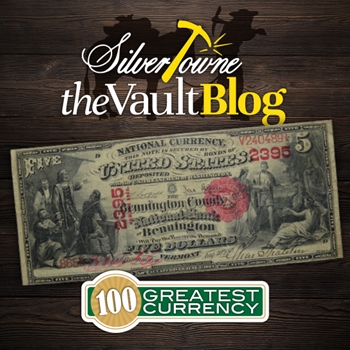
Currency notes work tremendously differently than coinage. When banks fail or notes are no longer usable from wear and tear, they can become redeemable. However, the process can be difficult, especially when sorting by location or banks. That is certainly the case with our next entry in our blog series following along with Whitman Publishing’s 100 Greatest American Currency Notes. Authors Q. David Bowers and David M. Sundman recall a National Bank Note series that remains extremely illusive today and are somehow easily and not so easily identifiable.
#54 – Original and Series of 1875 $5 “Black Charter” National Bank Note
When it comes to National Bank Notes, there are several variations of the $5 note as part of the Original and Series 1875 where the charter number is printed in black. When it comes to National Banks, several of them failed and their notes experienced heavy wear and tear during circulation. Many of their notes were redeemed by the Treasury Department as the clerks would receive the notes and have to sort them by bank and location. However, this was not as easy as it sounds as different fonts were used for names and addresses as well as the size of the fonts. The condition of the notes also mattered greatly as the poorer the condition, the harder it would be to identify them correctly. When identifying them, the records for the banks would be adjusted, showcasing how many bills and their denominations were still unsettled.
Back in the early 1870s, the Continental Bank Note Co. had the contract to print the faces of the $5 notes. They added the charter numbers directly on certain plates in heavy italic in two different locations. This was so that the bills could be sorted by quickly looking at them and not having to search for their bank name and location. The notes entered production in 1873 with the first deliveries to banks starting in December of that year. In June of 1874, an act was passed to overprint in red on the notes so that they could be even more identifiable at first glance. This ended the need for black numbers altogether. Approximately 45-50 notes are known to exist today.
In 1960, the historic market value of the $5 Black Charter National Bank Notes was $80 for a Very Fine condition. According to this publication (2006), that same grade was valued around $40,000.







